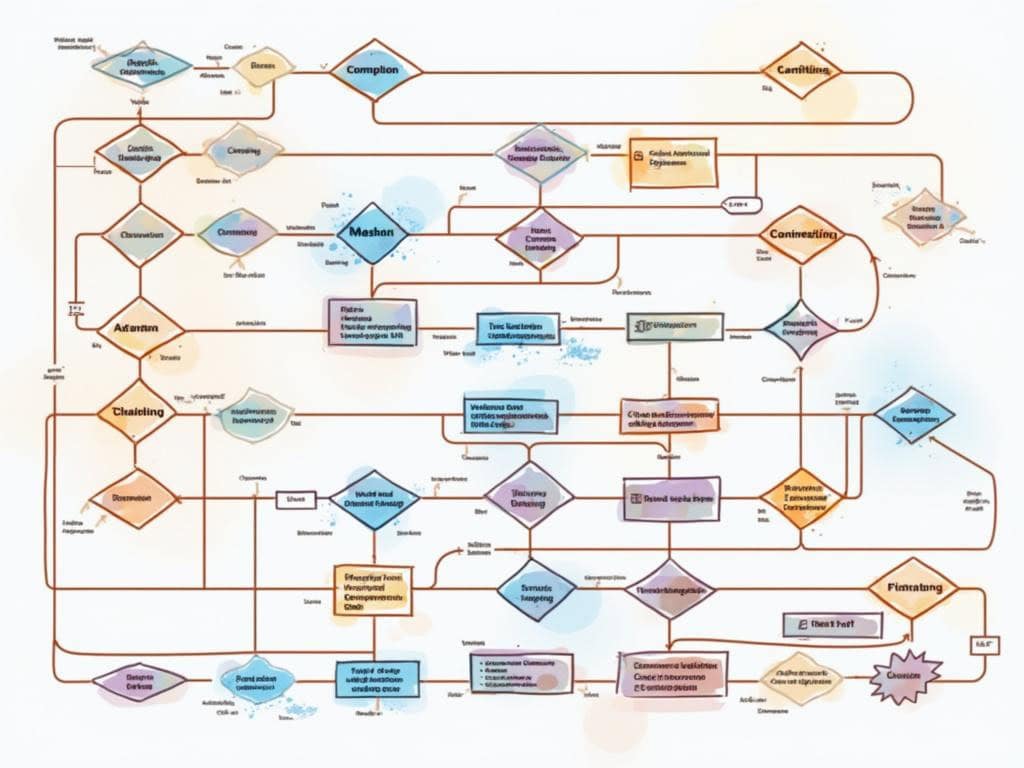
Process Mapping in Project Management
Process mapping in project management transforms complex workflows into clear, visual components. This technique helps teams understand project lifecycles through standardized symbols and detailed visual representations, boosting efficiency and team collaboration while providing valuable insights into workflow dynamics.
Key Takeaways
- Creates clear documentation for training new team members and maintaining process continuity
- Establishes consistent, repeatable procedures across different projects
- Supports compliance with industry standards and regulatory requirements
- Enables continuous workflow refinement and systematic process improvement
- Provides a framework for knowledge transfer during staff transitions
Effective process maps offer a bird’s-eye view of your entire project workflow. They highlight critical connections between tasks and identify potential bottlenecks before they impact your timeline. Visual process documentation also serves as a valuable communication tool when explaining procedures to stakeholders or team members.
You’ll find process mapping particularly useful when standardizing operations across departments or when onboarding new team members. The visual nature of these maps makes complex procedures accessible to everyone regardless of their technical background.
Process maps come in various formats, from simple flowcharts to detailed swim lane diagrams that track responsibilities across different teams. Choosing the right mapping style depends on your specific project needs and the level of detail required for implementation.
Regular review of your process maps contributes to a culture of continuous improvement. By analyzing these visual representations, you can spot inefficiencies and implement targeted process improvement methodologies that enhance overall project performance.
When creating your first process map, start with a high-level overview before breaking down each step into more detailed sub-processes. This approach prevents overwhelm and ensures your team captures the most critical workflow elements.
Digital process mapping tools now offer collaborative features that allow team members to contribute insights and updates in real-time, turning what was once a static document into a dynamic project management asset.
“Process mapping transforms intricate project workflows into clear visual narratives, fostering collaboration and efficiency while empowering teams to achieve continuous improvement. By standardizing procedures and enhancing documentation, it not only streamlines training but also ensures compliance and knowledge transfer, vital for sustained project success.”
Understanding Process Mapping
Process mapping in project management is a visual technique that breaks down complex project workflows into clear, digestible components. You’ll find this approach invaluable for visualizing and analyzing how work moves through your project lifecycle. Process mapping in project management uses standardized symbols to create a universal visual language—ovals represent start/end points, rectangles indicate process steps, and diamonds mark decision points.
When you implement process mapping in project management, you gain a comprehensive view of your entire project from initiation to completion. This visualization technique helps you identify connections between different project phases that might otherwise remain hidden. By mapping out each process step, you’ll create a foundation for effective project collaboration and workflow transparency.
Benefits for Team Communication and Efficiency
Process mapping in project management establishes a shared visual language across project teams, making complex workflows accessible to everyone. Your team members can clearly understand their roles and responsibilities within the larger project context. This clarity reduces misunderstandings and helps accelerate decision-making during critical project phases.
The strategic value of process mapping extends to identifying inefficiencies in your workflow. You can quickly pinpoint bottlenecks, redundant steps, and resource waste by analyzing your process maps. This allows for targeted improvements and process optimization methods that significantly reduce completion time and operational costs.
Process mapping in project management also strengthens your risk management capabilities. The visual representation helps you identify potential failure points early and develop appropriate contingency plans. This proactive approach to risk mitigation can save your projects from costly delays and setbacks.
Here are the key ways process mapping enhances your project management approach:
- Creates clear documentation for training new team members
- Establishes consistent, repeatable procedures across projects
- Supports compliance with industry standards and regulations
- Enables continuous workflow refinement and improvement
- Provides a framework for knowledge transfer during staff transitions
Process mapping in project management serves as an excellent training resource. Your new team members can quickly understand complex workflows through visual guidance, reducing the learning curve and maintaining process continuity during staff changes. This approach to knowledge mapping ensures critical process information remains accessible regardless of personnel changes.
Organizations that leverage process mapping effectively minimize operational costs by 20% and improve overall efficiency by up to 30%.
forbes.com
Enhancing Communication and Team Alignment
Process mapping in project management creates a shared visual language that transforms how your teams collaborate. You’ll notice immediate improvements in clarity and alignment when team members can reference the same visual workflow representation. Process mapping in project management eliminates confusion by clearly illustrating who does what and when.
Your project teams benefit from seeing task interconnections and dependencies visually mapped out. This transparency reduces misunderstandings that typically cause delays and conflicts. When each team member understands their precise role within the larger process, decision-making accelerates significantly. Process mapping in project management breaks down silos between departments, enhancing cross-functional collaboration.
Complex processes become simpler through effective visualization. The team collaboration benefits extend beyond your internal teams to include stakeholders and clients. By sharing process maps with stakeholders, you’ll facilitate clearer communication about project status, bottlenecks, and progress.
Benefits of Process Mapping for Team Communication
Process mapping in project management delivers several communication advantages:
- Creates visual reference points that transcend technical jargon
- Establishes clear handoff points between team members and departments
- Identifies communication channels and information flow
- Highlights decision points requiring input from specific team members
- Provides visual context for discussing process improvements
- Standardizes terminology across different functional areas
- Clarifies escalation paths when issues arise
Process mapping isn’t just documentation—it’s a dynamic communication tool. You can use it during team meetings to focus discussions on specific workflow areas. When implementing process changes, your visual maps become valuable tools for explaining modifications to team members.
| Communication Challenge | How Process Mapping Helps |
|---|---|
| Role confusion | Clearly defines who performs each task |
| Handoff issues | Shows exactly when work transfers between teams |
| Duplicate efforts | Highlights redundant activities across departments |
| Knowledge gaps | Identifies where information or expertise is missing |
| Decision bottlenecks | Maps approval workflows and decision points |
Process mapping in project management strengthens your stakeholder engagement approach by providing clear visuals of how their requirements translate into deliverables. You’ll find that visual process maps help bridge communication gaps between technical and non-technical team members.
Businesses that prioritize effective communication are 4.5 times more likely to succeed in achieving their business goals.
cio.com
Identifying and Eliminating Inefficiencies
Process mapping in project management serves as your secret weapon for uncovering hidden inefficiencies. You’ll find it easier to identify bottlenecks, redundant activities, and resource waste when you can visualize your entire workflow. Through detailed process mapping, you can spot where tasks pile up, where teams experience delays, and where resources aren’t being utilized effectively.
Process mapping in project management helps you target specific improvements by showing exactly where breakdowns occur. You can use these visual representations to analyze each step critically and determine which add value and which only create delays. This systematic approach helps you eliminate redundancies that often go unnoticed in daily operations.
Here are the key areas where process mapping in project management reveals inefficiencies:
- Workflow bottlenecks that slow down project progress
- Redundant approval steps that delay decision-making
- Resource allocation imbalances causing team burnout
- Communication gaps between departments
- Unnecessary documentation requirements
- Manual processes that could be automated
When you identify these inefficiencies through process mapping in project management, you can implement targeted solutions. This might include optimizing critical processes through automation, redistributing workloads, or simplifying approval chains.
Measuring Efficiency Gains
Process mapping in project management delivers quantifiable benefits across your projects. The following table illustrates typical efficiency improvements seen after implementing process mapping:
| Metric | Average Improvement | Impact on Project |
|---|---|---|
| Cycle Time | 20-30% reduction | Faster project completion |
| Resource Utilization | 15-25% improvement | More output with same resources |
| Error Rates | 40-60% reduction | Higher quality deliverables |
| Decision Speed | 30-45% improvement | Quicker response to issues |
| Team Productivity | 15-20% increase | Enhanced output per team member |
By leveraging process mapping in project management, you’ll create a culture of continuous improvement. Teams become more engaged when they can visualize their contributions and identify where they can make the process better. This approach also complements other methodologies like Six Sigma or Lean, offering a foundation for more advanced root cause analysis.
The most successful project managers use process mapping not as a one-time exercise but as an ongoing practice. You should revisit your process maps regularly to ensure they reflect current operations and continue to drive efficiency gains. This iterative approach helps you stay ahead of new inefficiencies before they become entrenched in your workflow.

Risk Management and Process Standardization
Process mapping in project management serves as a powerful tool for identifying potential risks before they impact your project timeline or budget. By visually representing each step in your workflow, you’ll quickly spot vulnerable points where problems commonly occur. This early risk detection allows you to develop robust contingency plans that address issues before they escalate.
When implementing process mapping for risk management, you’ll create a standardized approach that helps maintain consistency across all project activities. This standardization isn’t just about uniformity—it directly supports compliance with industry standards like ISO 9000, which many organizations must adhere to. Your mapped processes serve as evidence of quality control measures during audits and reviews.
Key Benefits of Process Mapping for Risk Management
Process mapping in project management enables you to establish clear protocols for handling exceptions and issues when they arise. You’ll find these mapped procedures particularly valuable during high-pressure situations when quick, informed decisions make the difference between minor setbacks and major failures. Here’s how process mapping strengthens your risk management approach:
- Risk visualization: Maps highlight decision points where risks commonly emerge, making them visible to all team members.
- Standardized response protocols: Creates consistent approaches to handling issues when they arise.
- Compliance documentation: Provides evidence of standardized procedures for regulatory requirements.
- Dependency identification: Reveals critical relationships between tasks that could trigger cascading failures.
- Process bottleneck detection: Identifies workflow constraints that may cause delays or resource conflicts.
Creating standardized processes through mapping also reduces individual interpretation of procedures. You’ll find this particularly valuable when conducting a post-implementation audit as it provides clear documentation of expected processes versus actual execution.
| Risk Management Objective | Process Mapping Contribution |
|---|---|
| Preventative Risk Management | Identifies potential failure points before they occur. |
| Reactive Risk Response | Provides clear escalation paths when issues arise. |
| Regulatory Compliance | Documents standardized procedures for audits. |
| Quality Assurance | Establishes consistent quality checkpoints. |
| Knowledge Preservation | Captures institutional knowledge about risk handling. |
Process mapping in project management also strengthens your effective risk response planning by creating clear visual guides that team members can follow during crisis situations. This visual approach helps eliminate confusion about next steps when problems emerge.
Companies with standardized processes are 30% more likely to achieve project success than those without.
forbes.com
Accelerating Training and Organizational Learning
Process mapping in project management delivers exceptional value as a training and knowledge transfer tool. You’ll find that well-designed process maps serve as comprehensive visual documentation that new team members can quickly understand. By capturing workflows visually, you cut the typical onboarding period by up to 40% compared to text-heavy manuals.
Building Organizational Knowledge Assets
Process mapping in project management creates enduring knowledge assets that remain valuable even during staff transitions. When experienced team members leave, their process knowledge doesn’t disappear with them. Instead, it lives on in detailed visual maps that preserve critical workflows and decision points.
Your process maps function as self-service learning tools that team members can reference independently. This approach to process mapping in project management supports different learning styles, particularly benefiting visual learners who comprise approximately 65% of your workforce.
The standardized symbols used in process mapping (ovals, rectangles, diamonds) create a universal language that transcends departmental boundaries. This standardization helps everyone understand project workflows regardless of their technical background or expertise level.
Here are key ways process mapping accelerates organizational learning:
- Provides visual reference points for complex project stages
- Establishes clear decision pathways for common scenarios
- Creates step-by-step guidance for critical procedures
- Documents dependencies between teams and departments
- Captures institutional knowledge that survives personnel changes
Process mapping in project management also supports continuous improvement efforts by giving teams a baseline for measuring progress. When you modify processes, you can update maps to reflect changes and immediately distribute updated knowledge throughout the organization.
During training sessions, process maps serve as discussion centerpieces that foster deeper understanding. New team members can trace entire workflows while asking targeted questions about specific steps, which promotes active listening and engagement.
The visual nature of process maps helps identify knowledge gaps that might otherwise remain hidden. When team members review maps together, they often discover assumptions or unwritten procedures that need clarification.
Process mapping in project management eliminates the “that’s how we’ve always done it” mentality by making implicit knowledge explicit. This transparency encourages critical thinking about each process step and empowers teams to question inefficient practices.
By implementing comprehensive process mapping, you’ll create a learning organization that adapts quickly to changes while maintaining operational excellence. This approach ensures project collaboration remains strong even as team composition evolves over time.
Implementing Process Mapping: Practical Applications and Benefits
Process mapping in project management delivers powerful advantages for your teams and workflows. You’ll gain measurable improvements in efficiency while creating a foundation for continuous operational advancement. When implemented correctly, process mapping transforms complex workflows into clear visual representations everyone can understand.
Process mapping in project management works as a continuous improvement methodology, enabling you to refine workflows iteratively. You can identify redundancies and bottlenecks by examining each process step visually. This allows you to optimize processes systematically rather than making random changes.
Creating adaptable, agile project management approaches becomes possible through effective process mapping. When requirements change or new challenges emerge, you can quickly adjust mapped processes to accommodate these shifts. Process mapping in project management helps you visualize these adaptations before implementation, reducing disruption to ongoing work.
Tools and Implementation Strategies
Several powerful tools support effective process mapping in project management:
- Microsoft Visio: Offers comprehensive diagramming capabilities with extensive process mapping templates
- Lucidchart: Cloud-based solution with real-time collaboration features
- Bizagi Modeler: Specialized in business process modeling with simulation capabilities
Process mapping in project management supports organizational learning by capturing institutional knowledge in visual formats. This documentation helps project teams collaborate more effectively, even when working remotely. The visual nature of process maps makes complex information accessible to diverse team members with different learning styles.
Your operational excellence initiatives gain structure through systematic process mapping in project management. By standardizing how processes are documented and analyzed, you create consistency across projects and departments. This standardization facilitates meaningful comparisons between processes and enables targeted improvements.
The most significant process mapping in project management benefit is its ability to drive operational adaptability. In rapidly changing business environments, organizations that can quickly adjust their processes gain competitive advantages. Process mapping gives you the tools to understand current workflows and model potential changes before committing resources.
When integrating process mapping in project management, you’ll discover opportunities for automation and innovation. The detailed visualization reveals steps that could be eliminated or enhanced through technology. This strategic approach to process mapping helps improve communication while supporting more informed decision-making throughout the project lifecycle.






